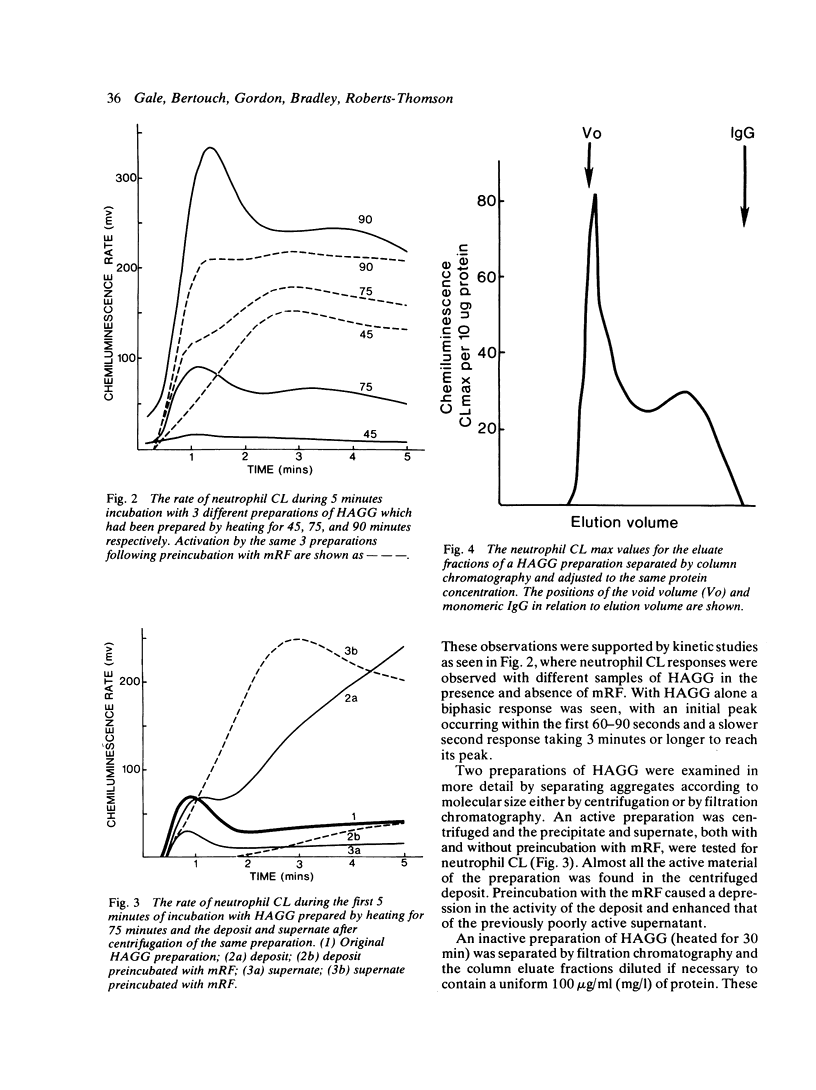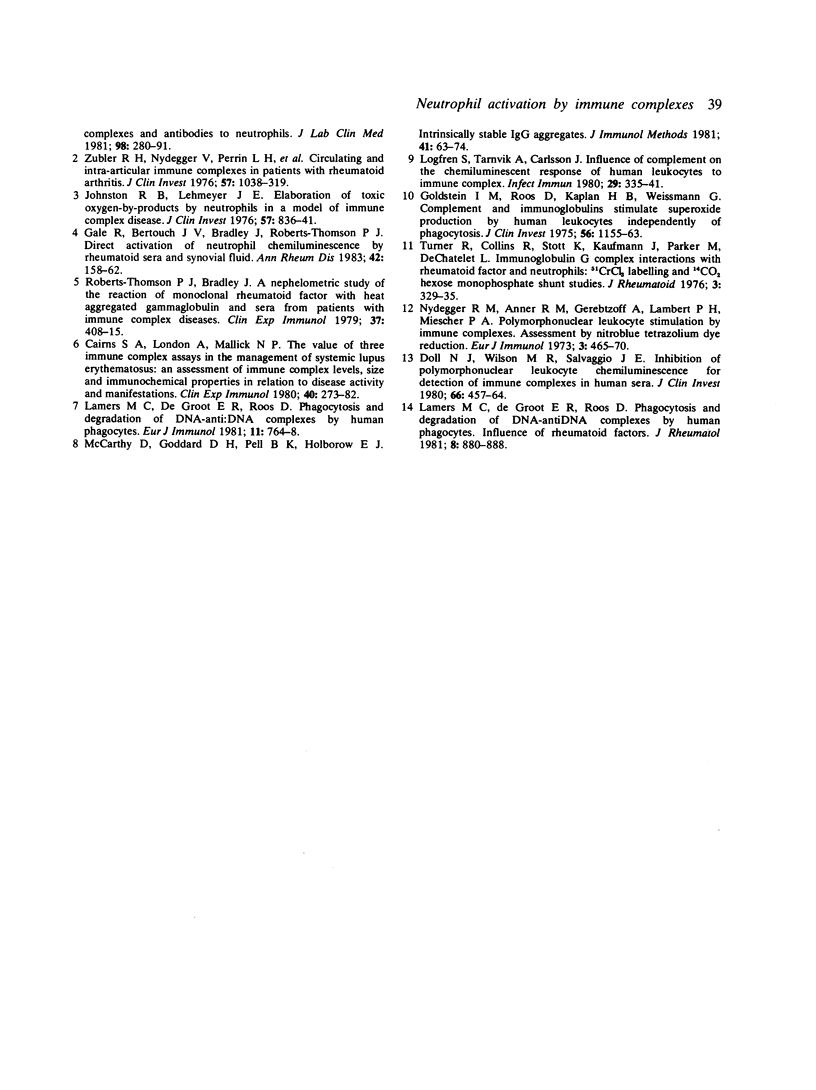Abstract
Membrane activation of human neutrophils by preformed immune complexes and heat aggregated human gammaglobulins was studied by chemiluminescence. Strong neutrophil activation was found with human-albumin rabbit-antialbumin complexes prepared at equivalence, with maximal activation occurring in slight antigen excess. Furthermore different preparations of heat aggregated gammaglobulin which were of large size also showed similar activity. In contrast, heat aggregates of small size were inactive and blocked the chemiluminescent response found with larger active aggregates. A purified monoclonal rheumatoid factor with specificity for IgG modulated these responses when preincubated with preformed complexes or aggregates. Both enhancement of the neutrophil chemiluminescence response with inactive preparations and suppression of the response with highly active preparations were observed. Kinetic studies of the neutrophil chemiluminescent response varied with respect to the activating preparation, but were generally biphasic. This observation suggested an initial direct membrane activation followed by a more delayed response reflecting phagocytosis of complexes. We have demonstrated the direct activation of neutrophil chemiluminescence by laboratory preparations of immune complexes. The chemiluminescent responses observed were influenced by both the size and immunochemical properties of the activating complexes and by the presence of rheumatoid factor. These observations may have important implications in the immunopathogenesis of immune-complex-mediated diseases.
Full text
PDF





Selected References
These references are in PubMed. This may not be the complete list of references from this article.
- Cairns S. A., London A., Mallick N. P. The value of three immune complex assays in the management of systemic lupus erythematosus: an assessment of immune complex levels, size and immunochemical properties in relation to disease activity and manifestations. Clin Exp Immunol. 1980 May;40(2):273–282. [PMC free article] [PubMed] [Google Scholar]
- Doll N. J., Wilson M. R., Salvaggio J. E. Inhibition of polymorphonuclear leukocyte chemiluminescence for detection of immune complexes in human sera. J Clin Invest. 1980 Sep;66(3):457–464. doi: 10.1172/JCI109876. [DOI] [PMC free article] [PubMed] [Google Scholar]
- Gale R., Bertouch J. V., Bradley J., Roberts-Thomson P. J. Direct activation of neutrophil chemiluminescence by rheumatoid sera and synovial fluid. Ann Rheum Dis. 1983 Apr;42(2):158–162. doi: 10.1136/ard.42.2.158. [DOI] [PMC free article] [PubMed] [Google Scholar]
- Goldstein I. M., Roos D., Kaplan H. B., Weissmann G. Complement and immunoglobulins stimulate superoxide production by human leukocytes independently of phagocytosis. J Clin Invest. 1975 Nov;56(5):1155–1163. doi: 10.1172/JCI108191. [DOI] [PMC free article] [PubMed] [Google Scholar]
- Johnston R. B., Jr, Lehmeyer J. E. Elaboration of toxic oxygen by-products by neutrophils in a model of immune complex disease. J Clin Invest. 1976 Apr;57(4):836–841. doi: 10.1172/JCI108359. [DOI] [PMC free article] [PubMed] [Google Scholar]
- Lamers M. C., De Groot E. R., Roos D. Phagocytosis and degradation of DNA-anti-DNA complexes by human phagocytes. I. Assay conditions, quantitative aspects and differences between human blood monocytes and neutrophils. Eur J Immunol. 1981 Oct;11(10):757–764. doi: 10.1002/eji.1830111005. [DOI] [PubMed] [Google Scholar]
- Lamers M. C., de Groot E. R., Roos D. Phagocytosis and degradation of DNA-antiDNA complexes by human phagocytes. Influence of rheumatoid factors. J Rheumatol. 1981 Nov-Dec;8(6):880–888. [PubMed] [Google Scholar]
- Löfgren S., Tärnvik A., Carlsson J. Influence of complement on the chemiluminescent response of human leukocytes to immune complex. Infect Immun. 1980 Aug;29(2):335–341. doi: 10.1128/iai.29.2.335-341.1980. [DOI] [PMC free article] [PubMed] [Google Scholar]
- McCarthy D., Goddard D. H., Pell B. K., Holborow E. J. Intrinsically stable IgG aggregates. J Immunol Methods. 1981;41(1):63–74. doi: 10.1016/0022-1759(81)90274-x. [DOI] [PubMed] [Google Scholar]
- Nydegger U. E., Anner R. M., Gerebtzoff A., Lambert P. H., Miescher P. A. Polymorphonuclear leukocytes stimulation by immune complexes. Assessment by nitroblue tetrazolium dye reduction. Eur J Immunol. 1973 Aug;3(8):465–470. doi: 10.1002/eji.1830030803. [DOI] [PubMed] [Google Scholar]
- Roberts-Thomson P. J., Bradley J. A nephelometric study of the reaction of monoclonal rheumatoid factor with heat aggregated gamma globulin and sera from patients with immune complex diseases. Clin Exp Immunol. 1979 Sep;37(3):408–415. [PMC free article] [PubMed] [Google Scholar]
- Starkebaum G., Stevens D. L., Henry C., Gavin S. E. Stimulation of human neutrophil chemiluminescence by soluble immune complexes and antibodies to neutrophils. J Lab Clin Med. 1981 Aug;98(2):280–291. [PubMed] [Google Scholar]
- Turner R., Collins R., Stott K., Kaufmann J., Parker M., DeChatelet L. Immunoglobulin G complex interactions with rheumatoid factor and neutrophils: 51CrCl3 labelling and 14CO2 hexose monophosphate shunt studies. J Rheumatol. 1976 Dec;3(4):329–335. [PubMed] [Google Scholar]


